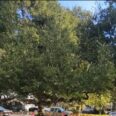
Fuller president David Emmanuel Goatley. [Courtesy of Fuller Seminary]
At a historic juncture, Fuller Theological Seminary embarks on a transformative journey with the submission of our Amended Master Plan (AMP) to the city of Pasadena. The AMP reflects a strategic repositioning that focuses on a more sustainable, reduced physical footprint while enhancing our digital outreach and maintaining essential in-person interactions that are critical to education. At the same time, the AMP seeks to support our community and strengthen existing partnerships.
As we stand on the shoulders of those who established Fuller 76 years ago in Pasadena, we are reminded of their foresight and commitment to adapt and thrive. The original vision for Fuller was bold and expansive, aimed at fostering a robust in-person learning environment. Today, the landscape of higher education has shifted dramatically, influenced heavily by the rise of online learning and changing student demographics. The COVID-19 pandemic accelerated this shift, underscoring the need for institutions to be flexible and technologically adept.
Our revised plan proposes smaller, more focused campus boundaries that prioritize core academic buildings and essential student services while offering state-of-the-art online learning experiences. This strategy allows Fuller to remain deeply and proudly rooted in Pasadena and to continue to contribute to, and draw from, the rich cultural and spiritual life of the city. Ultimately, the decision to retain certain properties as part of the master plan evaluated the importance of continuing to honor the city’s architectural heritage, sharing much needed green space, providing affordable housing for students, faculty, and employees and offering peaceful gardens for reflection and prayer.
The new campus boundaries will retain the historic National Register buildings along Oakland Avenue and Arol Burns Mall, the green walkable spine of campus. This grouping of stately buildings, approaching 120 years old, is equally important to Fuller as it is to the community. And Burns Mall, once a city street, has served as a quiet green space for the community since 1971. The small chapel and prayer garden along this block are also peaceful amenities that we will continue to share with the community.
Core properties that will remain part of our campus boundaries also include the Psychology Building that houses our growing psychology and marriage and family programs, and Chang Commons apartments that serve as the heart of student housing and community. Fuller remains committed to providing affordable housing to students, faculty, and employees, and ensuring access to a diverse student body.
Importantly, the AMP allows Fuller to continue to efficiently provide affordable mental health services to a diverse segment of the community. With services offered at only a fraction of the cost of market rates, Fuller provides more than 10,000 sessions per year, in four languages, to populations who otherwise could not access these services. We are profoundly proud of the impact of these services to the greater Pasadena community since 1964 and remain acutely focused on the importance of strengthening these programs in the future to better serve our neighbors.
The AMP also contemplates that, over the next decade, more than a dozen non-core properties will be positioned to be transitioned out of the plan and woven back into the fabric of the city. We will strive to support the city in achieving important housing and economic goals as we make parcels available through sales, leases, or partnerships. These properties, which are strategically located within walking distance of the Playhouse Village and Old Town Pasadena as well as the A Line (formerly the Gold Line), will provide abundant opportunities to help achieve the goals of the city’s General Plan for new housing, walkable neighborhoods, and expanding businesses.
In these changing times, Fuller’s mission to equip leaders for service remains unchanged. However, the methods by which we fulfill this mission must evolve. The AMP is a blueprint for a future that respects our past while boldly embracing new educational paradigms.
The AMP will be reviewed by multiple city commissions over the next six months with final authority at the City Council. The community outreach process begins with a community meeting on campus at Payton Hall on June 27 at 6:30pm and our Draft Plan document can be viewed on the Fuller webpage at: https://www.fuller.edu/master-plan. We hope the community will support us as we implement these changes. This plan is not just about physical space; it’s about hope and healing, creating an environment where faith, scholarship, and service converge in dynamic, innovative ways. It’s about laying a foundation for the next 76 years of our partnership with the Pasadena community and our impact on the world.
Questions about the AMP can be directed to masterplan@fuller.edu.
David Emmanuel Goatley is a distinguished theologian, missiologist, and academic administrator who currently serves as the sixth president of Fuller Theological Seminary.














 2 comments
2 comments


